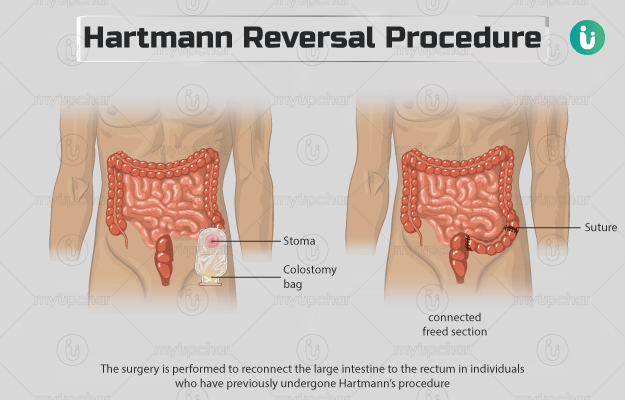After your admission to the hospital, the hospital staff will provide you with a hospital gown. They will start an intravenous (IV) line in your arm or hand to supply essential fluids and medicines during the surgery. If required, they will remove your hair around the area to be operated.
An anaesthetist will give you general anaesthesia. You may also be given epidural anaesthesia (medicine to numb the body from the waist down) before administration of general anaesthesia to control pain. Once you are asleep, a catheter (tube) will be inserted into your bladder to drain urine. The surgery will be performed by open or laparoscopic method.
Open surgery involves the following steps:
- The surgeon will make a vertical incision (cut) in your abdomen over the original incision made during the Hartmann’s procedure.
- He/she will free your large intestine from the scar tissue (adhesion) that is holding your intestines together and to the nearby abdominal organs. The surgeon will also free the sealed lower part of your large intestine.
- Next, the surgeon will make a cut around the stoma to free your large intestine from your abdominal skin.
- He/she will connect this freed section of your large intestine to your rectum with special staples or stitches.
- Finally, the surgeon will close the incisions and stoma on your abdominal skin with dissolvable stitches.
In laparoscopic surgery, the surgeon will:
- Make at least three small holes, about 1 cm wide, on your abdominal skin.
- Fill your abdomen with carbon dioxide to allow more area to operate.
- Introduce a special telescope (fitted with a camera) along with other special instruments into your abdomen through the holes.
The rest of the procedure (performed inside the abdomen) will be the same as that of open surgery.
After the surgery, the surgeon may insert a tube into the operated area to drain accumulated fluids. In some cases, a small temporary stoma may be created to allow the operated part of the intestine to heal. The surgery lasts for about 90 to 180 minutes. You may need to stay at the hospital for about five to 10 days, which may extend if you develop any complications. You can expect the following at the hospital after surgery:
- The hospital staff will move you to the intensive care unit (ICU) for close observation or directly to the recovery ward.
- Oxygen will be supplied to you through a facemask, and your vital signs will be regularly monitored.
- You will be given appropriate medicines to control pain and essential fluids will be administered to you through the IV line.
- The drain tube and catheter will be removed a few days after the surgery.
- You may receive injections daily to prevent the formation of blood clots in the legs.
- The hospital staff will encourage and assist you in getting out of the bed and walking around. This will help promote healing along with preventing blood clot formation in your legs.
- You will be taken to the regular ward once your condition is stable.
Compared to open surgery, laparoscopic surgery is associated with a shorter hospital stay, reduced postoperative pain, and minimal scarring.










































